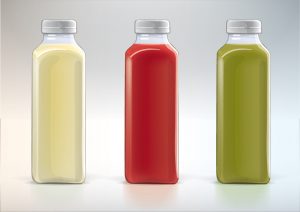
Vegetables are good for you.
So, you’d easily assume that eating lots of vegetables is thereby super good for you.
Right?
But there are definite problems with drinking lots of green juice – i.e., vegetable juice.
Your Juice Isn’t Really Green:
Sure, your juice looks green. But many green juices are actually chock-full of fruit juice – to make green juices more palatable. When you’re sipping down a big bottle, the sugar and carbohydrate content from all that concentrated fruit can really add up. While your body may appreciate all the vitamins, it’s important to keep in mind that too many extra carbs and too much of a deluge of sugar can wind up feeding your fat cells.
Grab my Longevity Smoothie Recipe – which has the 3 best alkaline veggies – to help you live longer and younger.
Your Juice is More than 1 Hour Old:
When you juice, you break down the cell walls and expose the fruit to oxygen, decreasing the amount of nutrients in your juice every second  after it has been made.
after it has been made.
As a result, you are getting practically no nutritional benefit from consuming bottled juices sitting too long on a store’s shelf.
Basically, if it has been sitting out for more than an hour (and many juices stay on store shelves much, much longer than that), it’s done for.
It’s Better to Eat Your Fruits Than to Drink Them:
Juicing can be a great way to squeeze more produce into your diet, in a tidy little bottle. Unfortunately, drinking it isn’t the same as eating – when it comes to your body feeling full.
- Research shows that even when fiber is added to juice, it’s not as satiating as whole produce.
Think about it. First you have to take time to chew – and it takes far more time to chow down whole veggies and fruits than it does to swig down a glass of ’em.
The delayed time helps you to figure out how full you feel – so don’t eat more than you need.
Also, solid food takes up more space in your stomach – and so you feel fuller sooner.
- If you’re trying to lose weight you’re better off eating a salad or nibbling on raw green veggies.
- Try palate-pleasers and vitamin-givers like: broccoli, snow peas, sliced bell pepper, cucumber slices, celery stalks, or string beans.
You’re Neglecting Your Other Veggie Friends:
 The biggest con of trendy foods:
The biggest con of trendy foods:
They soak up all the limelight, and leave their healthy counterparts in the shadows.
Yes, kale is great for you.
But so are:
red veggies (like beets, peppers, and tomatoes), yellow and orange plants (including carrots, sweet potatoes, and squash), blue/purple veggies (such as eggplant and cabbage), and even white options (like cauliflower, mushrooms, and onions).
- Because each plant food contains unique disease-fighting substances, you’re best off eating a wide variety of veggies – thereby exposing your body to a broader spectrum of protection.
Green Juice is Expensive:
One ready-to-drink bottle of green juice costs anywhere between $3.50 and $13.00 – depending on how it’s made.
If you’re trying to eat healthier, it’s a lot more affordable just to buy vegetables. You can find them in pretty much in every grocery store – and even some drug store chains like Duane Reade and CVS now carry vegetables. And of course there’s your local farmers market. Or if you’re feeling ambitious you can even grow your own garden.
In Summary…
Vegetable juice is actually good for you if…
- a green juice is truly made of vegetables ( instead of being a fruit juice in disguise as green juice)
- you get them tailor-made fresh at a shop
- you make them for yourself at home
The goal:
- Include healthful green juices as a part of your balanced diet.
- Do not count on green juice as a substitution for a complete meal.
- Try to enjoy your veggies in solid form more often than you do in juice form. Your body will thank you for it.
Want to live longer and younger? Check out my longevity book – LIFE IS LONG: 50+ ways to live a little closer to forever. Get cutting-edge knowledge to protect you from age-related diseases and dementia. Learn more!
Think happier. Think calmer.
Think about subscribing for free weekly tools here.
No SPAM, ever! Read the Privacy Policy for more information.
One last step!
Please go to your inbox and click the confirmation link we just emailed you so you can start to get your free weekly NotSalmon Happiness Tools! Plus, you’ll immediately receive a chunklette of Karen’s bestselling Bounce Back Book!



 after it has been made.
after it has been made. The biggest con of trendy foods:
The biggest con of trendy foods: